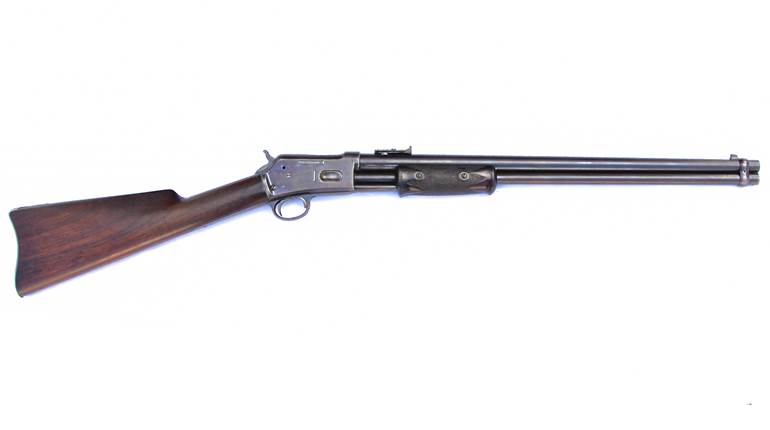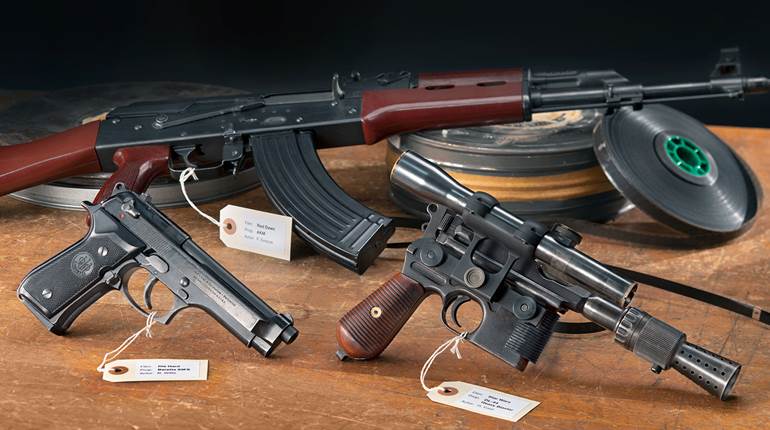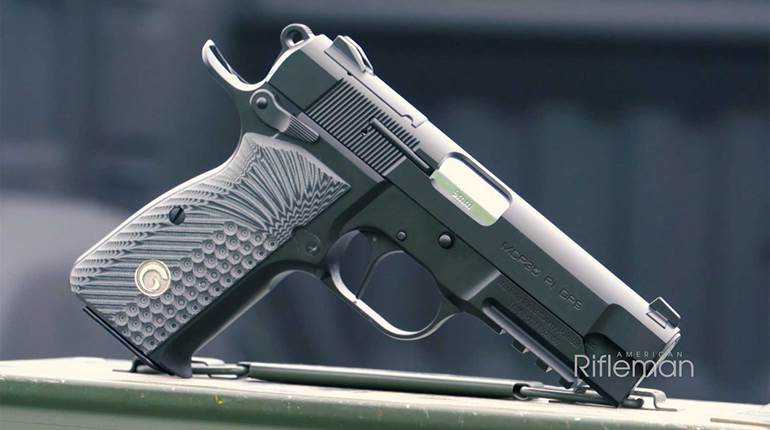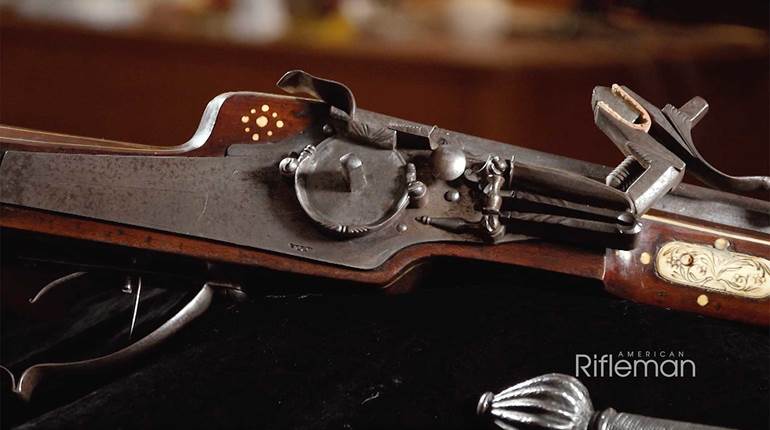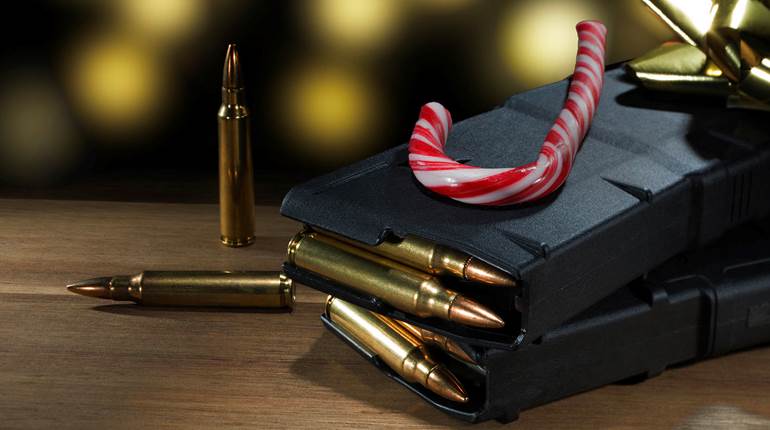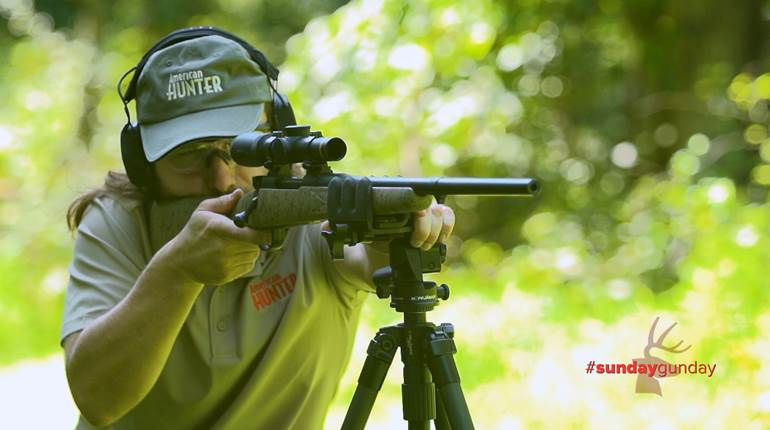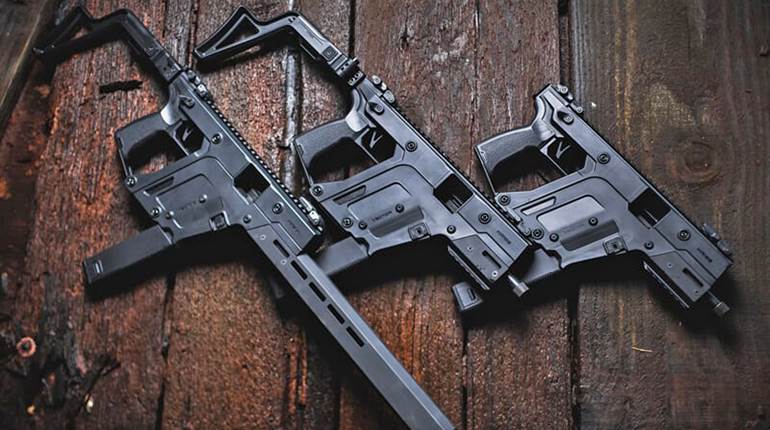
Out of production and somewhat obscure, the Smith & Wesson Model 29 was once well known only to serious big-bore handgunners. Then in 1971, it became one of the most famous and desirable handguns of all time. Do you know why? Well, do ya?
There is only a handful of motion pictures in which a specific gun played a starring role. “Winchester 73,” a 1950 Western that follows the trail of a stolen lever-action back to its rightful owner, and “Carbine Williams,” the 1952 film about David Marshal Williams and the M1 carbine, are two that come to mind. Interestingly, both starred Jimmy Stewart. But in these movies the guns took second billing to the starring character.
Such was not the case with “Dirty Harry” in 1971, starring Clint Eastwood, for the Smith & Wesson Model 29 that he packed in a Bucheimer-Clark shoulder holster and that was interwoven into his movie character, Inspector Harry Callahan. Who can forget those taunting, haunting words uttered by Eastwood as he squinted down that 6½-inch barrel aimed at actor Albert “Poppy” Popwell:
“I know what you’re thinking. ‘Did he fire six shots or only five?’ Well, to tell you the truth, in all this excitement I kind of lost track myself. But being as this is a .44 Magnum, the most powerful handgun in the world, and would blow your head clean off, you’ve got to ask yourself one question: ‘Do I feel lucky?’ Well, do ya, punk?”
What erupted immediately after that wasn’t the roar of a .44 Mag., but a frenzied public clamoring for an S&W Model 29-which, at that time, really was the most powerful commercially made handgun in the world. The sudden nationwide desire to own a .44 Mag. took S&W by surprise, as prior to the release of “Dirty Harry,” demand for the bulky, hard-recoiling handgun had fallen so low that the Model 29-though still cataloged-was out of production. Then, overnight the Model 29 was on everybody’s “most wanted” list. As a result, Model 29s were selling for as much as three times their suggested retail price of $194-when they could be found.
Demand continued two years later when, in the “Dirty Harry” sequel “Magnum Force,” Eastwood repeats his “This is a 44. Magnum, the most powerful handgun in the world” soliloquy during the opening credits, as he cocks and aims his Model 29 at the audience. As Dirty Harry, Eastwood packed his Model 29 three more times, in “The Enforcer” in 1976, in “Sudden Impact” in 1983, and finally in “The Dead Pool” in 1988, the last Dirty Harry movie he swore he’d ever make. But to this day, whenever a Dirty Harry movie airs on TV or cable, Model 29 sales surge.
The Dirty Harry blockbuster franchise was fortuitous for Eastwood (who took the role only after it had been turned down by Frank Sinatra, Steve McQueen and John Wayne, among others), Warner Brothers (who got the script when Universal Studios let the rights to it elapse), and most of all, S&W, who had the right gun at the right time. But the Model 29 Eastwood packs in the films was not quite the gun originally depicted for his character in the script written by writer-producer-director and NRA board member John Milius, who wrote the first two films, although he is uncredited in the first one.
“This is the gun Dirty Harry should have used,” Milius told me at his home a few years ago, as he reached into his desk and pulled out a 4-inch barreled Model 29 with ivory stocks. Indeed, his Sept. 23, 1970, movie draft calls for exactly such a gun in nickeled finish. But, as previously noted, Model 29s were in short supply at the time (due to lack of demand, not popularity, as is commonly believed) and there were no 4-inch models to be had. Consequently, according to S&W historian Roy Jinks, Kelly Lookabaugh, S&W’s West Coast Representative who had close ties with Hollywood, brought a 6½-inch blued model to the Warner Brothers studios. The gun had been assembled in the late 1960s by Archie Dubia, foreman of S&Ws hand-fitting department. Studios normally like to have at least one backup gun and preferably two, in case the primary gun gets damaged during filming. Thus, Milius lent, gave or brought (the details vary, depending on who you ask) two 6½-inch Model 29s to the studio. Later, he presented one of these guns to Clint Eastwood, who, last I heard, still has it.
But a different version of the first “Dirty Harry” Model 29s is chronicled by the Internet Movie Firearms Database (IMFDB). According to it, when a 4-inch Model 29 proved unobtainable, Eastwood personally contacted S&W representative Bob Sauer, who in turn had Fred Miller (who originally had helped develop the production model of the .44 Magnum) at the factory assemble two guns, one with a 6½-inch barrel and the other with an 83⁄8 inch, from parts on hand.
It is unclear which of the two versions are true, but this much is known: after the completion of “Magnum Force,” Warner Brothers presented Milius with a Model 29 with an engraved silver shield inlaid on the left grip which reads:
The gun, serial number S206921, on loan from Milius, is currently on display at the National Firearms Museum in Fairfax, Va. Thus, we can lay to rest the recurring myth that because Model 29s were unobtainable during the filming of the first Dirty Harry film, the look-alike .41 Mag. Model 57 was used instead. As the facts attest, that simply is not true. And to further set the record straight, although the first guns used were N-frames, in the final three films the Model 29s used were all N-frames rented from Ellis Mercantile, a well-known Hollywood prop house no longer in business. In addition, a rubber mock-up Model 29 was used in scenes that called for the gun to be thrown. In one verified “Dirty Harry” incident filmed near Coit Tower, however, Eastwood throws his real gun, which is supposed to land on an off-camera padded blanket, but it misses. That metallic clattering you hear in the movie of the S&W rattling along the sidewalk is real!
“That’s the gun I really wanted,” Milius lamented during the 2001 NRA Convention, “because you could prove it had real screen-time.” But that gun had disappeared. As an aside, the Bucheimer-Clark shoulder holster Eastwood used in the first two Dirty Harry films was rented from Ellis Mercantile but was for a gun with a 5-inch barrel, which caused the Model 29 Eastwood used to ride high in the rig.
Eastwood wasn’t the first actor to use a Model 29. In 1967 Lee Marvin packed a 4-inch version in “Point Blank,” faking recoil (only blanks are used in movies) in one scene, but forgetting to depict it in another. (On the other hand, Eastwood-ever the consummate actor-took a Model 29 to the shooting range to experience the recoil of a .44 Mag. so he could accurately portray firing the gun on screen.) And in 1973 James Bond, played by Roger Moore, used a nickeled version briefly in “Live and Let Die,” while 10 years later Chuck Norris upped the ante by brandishing an engraved, nickel-plated Model 29 as Texas Ranger J.J. McQuade in “Lone Wolf McQuade.” Nonetheless, the first actor to actually own a Model 29 was the late Jack Webb, star of TV’s “Dragnet.” On Feb. 29, 1956, S&W presented the actor-producer-director-writer with serial number S130714 (Webb’s Dragnet character, Sgt. Joe Friday, carried badge number 714 on the popular detective show). It was the 12th .44 Magnum produced by Smith & Wesson.
But television and movies aside, the real story of the Model 29 began during the late 1930s with a group of big-bore revolver aficionados, including such luminaries as Elmer Keith, P.O. Ackley and Townsend Whelen, who weren’t satisfied with the S&W Registered .357 Mag., which at that time, really was “the most powerful handgun in the world.” They wanted something more, and just as the .38 Spl. begat the .357 Mag., they turned to the .44 Spl. as the basis for their proposed powerhouse cartridge. Having been developed in 1907 as a longer-cased smokeless-powder version of the old .44 Russian blackpowder cartridge, and specifically chambered in S&W’s First Model Hand Ejector of 1908, a sturdy double-action also known as the Triple Lock, the .44 Spl. was loaded to blackpowder velocities, which did not do justice to cartridge or gun.
Leading the crusade for a “.44 Special Magnum,” as he called it, Keith proceeded to blow up numerous revolvers until at last he had the cartridge he wanted. He convinced Remington to manufacture it, but not before lengthening the .44 Spl. case one-tenth of an inch, to keep others from duplicating Keith’s cylinder-exploding exploits. The result was the .44 Rem. Mag. cartridge, which fired a 240-grain Keith-designed bullet at 1,400 fps. At 50 yards, it hit with more than 750 ft.-lbs. of energy, almost double that of the .357 Mag. cartridge.
All that was needed was a handgun capable of handling the cartridge. For that, S&W turned to its S-frame Triple Lock, which by then had evolved into the Hand Ejector Fourth Model, better known as the 1950 Target Model in .44 Spl. (later to become the Model 24) and the 1955 Target Model (basically the same gun but in .45 caliber and with a heavier barrel; later it became the Model 25). But first some tweaking had to be done, which included lengthening the cylinder to close up the barrel-cylinder gap and incorporating recessed chambers. When completed, the gun weighed 48 ounces, which helped tame the recoil. As that was before S&W started incorporating model numbers for its handguns, the behemoth six-shot revolver was simply called the “.44 Magnum,” which was rollmarked along the right side of the barrel.
“The first .44 Magnum built was in December 1955,” notes Jinks. “The serial numbers started at S131700 and were mixed up in the early production with some of the early production guns having serial numbers as high as S167124. The reason for this was that the factory was using frames that had already been built, but were for the .45 Target Model of 1955. That frame was already set up for the heavy barrel that was going on the .44 Magnums.”
On Dec. 29, .44 Magnum number S130806, the second gun to be produced, was presented to R.H. Coleman of Remington Arms Co. On Jan. 19, 1956, the revolver was officially announced to the public. The initial price was $135, but was almost immediately raised to $140. The gun was housed in a satin-lined black wooden case embossed with “.44 Magnum” and the S&W logo on the lid. Inside were a screwdriver, cleaning rod, and wire brush and cotton swab attachments. The .44 Magnum was available in either a 4-inch or 6½-inch barrel, fitted with Goncala Alves target stocks, and came in blue or nickel finish, with case hardened hammer and trigger and Micro Adjustable sights.
Of the guns produced in January 1956, serial number S147220, went to Keith and number S130942 was shipped to Maj. Gen. Julian S. Hatcher, Technical Editor of The American Rifleman. Other notable gunwriters also received 6½-inch-barreled versions. Hatcher’s review of the .44 Magnum appeared in this magazine’s March 1956 issue. Needless to say, the gun was an instant success, with about 3,100 made that year. The .44 Magnum appealed to hunters impressed with Keith’s tales of long-range kills made with it. The law enforcement community was equally enamored with the .44 Magnum’s potential for stopping cars at substantially closer distances. It soon became apparent, however, that shooting such a heavy-recoiling handgun wasn’t something to do for any length of time. Stoking it with milder .44 Spl. Loads-which also chambered in the .44 Magnum-soon became de rigueur.
I succumbed to Model 29 fever in 1979. Until then, as a gunwriter just starting out penning articles for this magazine and others, I couldn’t afford the inflated Model 29 prices. But that year, Abercrombie & Fitch, then a true outdoor outfitter, was opening a store in Beverly Hills and had an allocation of three Model 29s-one in each barrel length. And they were going to be sold at retail price, which at that time had climbed to $354.50, with the 83⁄8-inch barrel (which always brought a premium) at $366. When A&F’s doors opened that first day I sprinted up the steps two at a time to the mezzanine where the gun department was located and slapped my money down for the 83⁄8-inch model.
I still have it, along with a few others, including a 6½-inch version shipped as a test gun in 1957 to an unidentified gunwriter in New York who marked the frame with his distinctive six-dot punch pattern. He had fired so many full-house loads through it that I had to have the barrel turned back to 6¼ inches to reduce the cylinder gap.
Interestingly, the earliest guns had right-hand threads on the ejector rod screw, which caused it to back out and jam due to recoil. From Model variation 29-1 on, that was changed to left-hand threads, solving the problem. Reflecting a change in designation throughout the Smith & Wesson line, in late 1957, starting with serial number S179000, the .44 Magnum became the Model 29. As Jinks notes, however, the changeover was sporadic, and between 1957 and 1958 guns marked both .44 Magnum and Model 29 were shipped concurrently.
The 83⁄8-inch barrel was added in November 1958 and the black wooden case was changed to mahogany in 1960. The Gun Control Act of 1968 resulted in the S-frame designation being changed to an N-frame prefix, and in 1979 the 6½-inch barrel was shortened to 6 inches in order to standardize production, according to Jinks, who actually suggested the change. In 1981, the counterbored cylinder chambers and pinned barrel were eliminated as both were unnecessary. Later, the pivoting, hammer-mounted firing pin was changed to a frame-mounted version. Other internal modifications continued through the 1990s, including improved yoke retention and longer cylinder locking bolts.
Externally the Model 29 received many makeovers, including Model 629 stainless steel versions and Performance Center specials, plus barrel lengths ranging from an exclusive three-incher for distributor Lew Horton to a 105⁄8-inch factory Silhouette model. In addition, in chronological order, there were five-, four-, and three-screw models. In 1999 the Model 29 was discontinued, but, in 2006 it was brought back as a 50th Anniversary Commemorative (technically missing it by a year) with a 6½-inch barrel and engraved gold medallion on the frame. Today the Model 29 is still available as a limited-production Classic Model in nickel or blued finish (albeit with a key lock on the left side plate) with a 4- or 6½-inch barrel. Plus, handsome laser-etched versions of the gun were introduced in 2009 and 2010. Unfortunately, according to Paul Pluff, S&W’s director of marketing/customer service, “We do not have any new Model 29s that have been recently or [are] going to be released.”
Whether or not that situation continues remains to be seen. After all, in a 2008 survey, 20th Century Fox asked moviegoers to name their favorite on-screen arms. The Model 29 came in second only to Luke Skywalker’s lightsaber. Frankly, I’d take the Model 29 over the lightsaber any day. It has far greater range and doesn’t need special effects to make it work. I kind of think Dirty Harry would agree.














